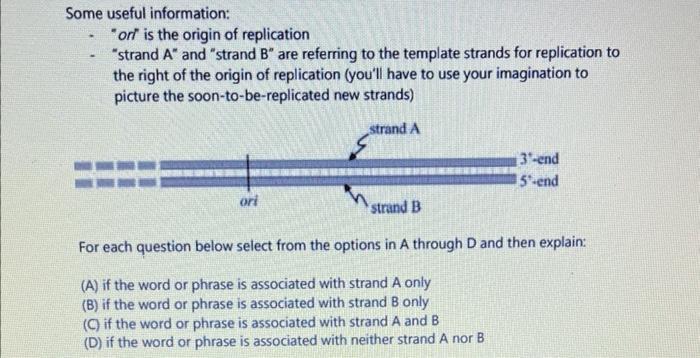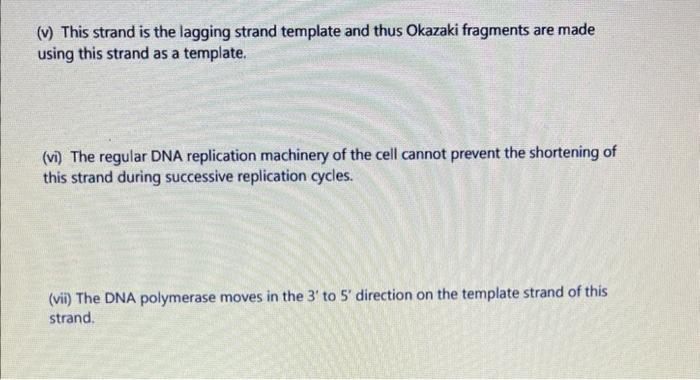Answered step by step
Verified Expert Solution
Question
1 Approved Answer
Below is a diagram showing the template strands of a chromosome that will soon be replicated. The end of the chromosome shown on the




Below is a diagram showing the template strands of a chromosome that will soon be replicated. The end of the chromosome shown on the right is the actual end of the Some useful information: "or" is the origin of replication "strand A" and "strand B" are referring to the template strands for replication to the right of the origin of replication (you'll have to use your imagination to picture the soon-to-be-replicated new strands) strand A ori 3-end 15-end strand B For each question below select from the options in A through D and then explain: (A) if the word or phrase is associated with strand A only (B) if the word or phrase is associated with strand B only (C) if the word or phrase is associated with strand A and B (D) if the word or phrase is associated with neither strand A nor B (1) Replication of this strand involves a single primer molecule. (ii) Replication of this strand involves several primer molecules. (iii) Replication of this strand does not need primer. (vi) This strand is the leading strand template. (v) This strand is the lagging strand template and thus Okazaki fragments are made using this strand as a template. (vi) The regular DNA replication machinery of the cell cannot prevent the shortening of this strand during successive replication cycles. (vii) The DNA polymerase moves in the 3' to 5' direction on the template strand of this strand. Below is a diagram showing the template strands of a chromosome that will soon be replicated. The end of the chromosome shown on the right is the actual end of the Some useful information: "or" is the origin of replication "strand A" and "strand B" are referring to the template strands for replication to the right of the origin of replication (you'll have to use your imagination to picture the soon-to-be-replicated new strands) strand A ori 3-end 15-end strand B For each question below select from the options in A through D and then explain: (A) if the word or phrase is associated with strand A only (B) if the word or phrase is associated with strand B only (C) if the word or phrase is associated with strand A and B (D) if the word or phrase is associated with neither strand A nor B (1) Replication of this strand involves a single primer molecule. (ii) Replication of this strand involves several primer molecules. (iii) Replication of this strand does not need primer. (vi) This strand is the leading strand template. (v) This strand is the lagging strand template and thus Okazaki fragments are made using this strand as a template. (vi) The regular DNA replication machinery of the cell cannot prevent the shortening of this strand during successive replication cycles. (vii) The DNA polymerase moves in the 3' to 5' direction on the template strand of this strand. Below is a diagram showing the template strands of a chromosome that will soon be replicated. The end of the chromosome shown on the right is the actual end of the Some useful information: "or" is the origin of replication "strand A" and "strand B" are referring to the template strands for replication to the right of the origin of replication (you'll have to use your imagination to picture the soon-to-be-replicated new strands) strand A ori 3-end 15-end strand B For each question below select from the options in A through D and then explain: (A) if the word or phrase is associated with strand A only (B) if the word or phrase is associated with strand B only (C) if the word or phrase is associated with strand A and B (D) if the word or phrase is associated with neither strand A nor B (1) Replication of this strand involves a single primer molecule. (ii) Replication of this strand involves several primer molecules. (iii) Replication of this strand does not need primer. (vi) This strand is the leading strand template. (v) This strand is the lagging strand template and thus Okazaki fragments are made using this strand as a template. (vi) The regular DNA replication machinery of the cell cannot prevent the shortening of this strand during successive replication cycles. (vii) The DNA polymerase moves in the 3' to 5' direction on the template strand of this strand. Below is a diagram showing the template strands of a chromosome that will soon be replicated. The end of the chromosome shown on the right is the actual end of the Some useful information: "or" is the origin of replication "strand A" and "strand B" are referring to the template strands for replication to the right of the origin of replication (you'll have to use your imagination to picture the soon-to-be-replicated new strands) strand A ori 3-end 15-end strand B For each question below select from the options in A through D and then explain: (A) if the word or phrase is associated with strand A only (B) if the word or phrase is associated with strand B only (C) if the word or phrase is associated with strand A and B (D) if the word or phrase is associated with neither strand A nor B (1) Replication of this strand involves a single primer molecule. (ii) Replication of this strand involves several primer molecules. (iii) Replication of this strand does not need primer. (vi) This strand is the leading strand template. (v) This strand is the lagging strand template and thus Okazaki fragments are made using this strand as a template. (vi) The regular DNA replication machinery of the cell cannot prevent the shortening of this strand during successive replication cycles. (vii) The DNA polymerase moves in the 3' to 5' direction on the template strand of this strand. Below is a diagram showing the template strands of a chromosome that will soon be replicated. The end of the chromosome shown on the right is the actual end of the Some useful information: "or" is the origin of replication "strand A" and "strand B" are referring to the template strands for replication to the right of the origin of replication (you'll have to use your imagination to picture the soon-to-be-replicated new strands) strand A ori 3-end 15-end strand B For each question below select from the options in A through D and then explain: (A) if the word or phrase is associated with strand A only (B) if the word or phrase is associated with strand B only (C) if the word or phrase is associated with strand A and B (D) if the word or phrase is associated with neither strand A nor B (1) Replication of this strand involves a single primer molecule. (ii) Replication of this strand involves several primer molecules. (iii) Replication of this strand does not need primer. (vi) This strand is the leading strand template. (v) This strand is the lagging strand template and thus Okazaki fragments are made using this strand as a template. (vi) The regular DNA replication machinery of the cell cannot prevent the shortening of this strand during successive replication cycles. (vii) The DNA polymerase moves in the 3' to 5' direction on the template strand of this strand. Below is a diagram showing the template strands of a chromosome that will soon be replicated. The end of the chromosome shown on the right is the actual end of the Some useful information: "or" is the origin of replication "strand A" and "strand B" are referring to the template strands for replication to the right of the origin of replication (you'll have to use your imagination to picture the soon-to-be-replicated new strands) strand A ori 3-end 15-end strand B For each question below select from the options in A through D and then explain: (A) if the word or phrase is associated with strand A only (B) if the word or phrase is associated with strand B only (C) if the word or phrase is associated with strand A and B (D) if the word or phrase is associated with neither strand A nor B (1) Replication of this strand involves a single primer molecule. (ii) Replication of this strand involves several primer molecules. (iii) Replication of this strand does not need primer. (vi) This strand is the leading strand template. (v) This strand is the lagging strand template and thus Okazaki fragments are made using this strand as a template. (vi) The regular DNA replication machinery of the cell cannot prevent the shortening of this strand during successive replication cycles. (vii) The DNA polymerase moves in the 3' to 5' direction on the template strand of this strand. Below is a diagram showing the template strands of a chromosome that will soon be replicated. The end of the chromosome shown on the right is the actual end of the Some useful information: "or" is the origin of replication "strand A" and "strand B" are referring to the template strands for replication to the right of the origin of replication (you'll have to use your imagination to picture the soon-to-be-replicated new strands) strand A ori 3-end 15-end strand B For each question below select from the options in A through D and then explain: (A) if the word or phrase is associated with strand A only (B) if the word or phrase is associated with strand B only (C) if the word or phrase is associated with strand A and B (D) if the word or phrase is associated with neither strand A nor B (1) Replication of this strand involves a single primer molecule. (ii) Replication of this strand involves several primer molecules. (iii) Replication of this strand does not need primer. (vi) This strand is the leading strand template. (v) This strand is the lagging strand template and thus Okazaki fragments are made using this strand as a template. (vi) The regular DNA replication machinery of the cell cannot prevent the shortening of this strand during successive replication cycles. (vii) The DNA polymerase moves in the 3' to 5' direction on the template strand of this strand.
Step by Step Solution
★★★★★
3.30 Rating (147 Votes )
There are 3 Steps involved in it
Step: 1
Strand A Lagging strand Strand B Leading strand Explanation The DNA strands ends are presented on the right side of the diagram and the dotted line on ...
Get Instant Access to Expert-Tailored Solutions
See step-by-step solutions with expert insights and AI powered tools for academic success
Step: 2

Step: 3

Ace Your Homework with AI
Get the answers you need in no time with our AI-driven, step-by-step assistance
Get Started


